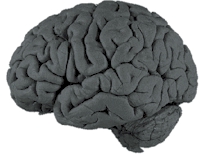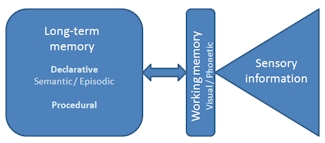![]() Throughout 2011 we will be publishing extracts from The New Learning Architect. We move on to the third part of chapter 3:
Throughout 2011 we will be publishing extracts from The New Learning Architect. We move on to the third part of chapter 3:
To quote Frank Felberbaum: “Each adult brain is endowed with approximately 100 billion neurons (nerve cells) – half of all the nerve cells in the body – but that’s just the starting point. From the moment we commence thinking, remembering, observing and learning, we are literally recreating our brains. Scientists have estimated that each of us has the capacity to make up to 10 trillion connections among our neurons, although most of us take advantage of only a small portion of this capacity. Each time we make a new connection we actually make ourselves smarter, not just because we know more, but because our brain actually works better.”

It’s time for a quick tour of the brain. Rising from the top of the spinal column is the brain stem, the oldest part of your brain, sometimes called the ‘reptilian brain’. The brain stem ‘remembers’ how to carry out the most basic functions necessary to keep us alive, regulating our breathing, heartbeat, sleep and waking.
Sitting on top of the brain stem is the limbic system, also known as the ‘old mammalian brain’. Here is where our emotions reside – all those survival-oriented feelings we need to keep the species going and to recognise danger and safety (although we may also have developed more sophisticated uses for our emotions). Here, too is the part of the brain that interprets sensory data, enabling us to respond quickly to danger.
The most uniquely human portions of our brain are the cerebellum and the cerebrum. When you’ve learned to do something so well that it becomes automatic – such as driving a car, riding a bike, typing or operating a computer – that memory, known as procedural memory (or sometimes ‘muscle memory’) is stored in your cerebellum, which sits just behind your brain stem.
The cerebrum consists of about two-thirds of our brain, which is where our personal memories are stored. The cerebrum is divided into two hemispheres, popularly known as the ‘left brain’ and the ‘right brain’. Although brain function is more fluid than these terms suggest, we can say generally that the left side of the brain handles logical thought, analysis, numbers and words, while the right side recognises patterns, perceives spatial relations and tends to think in images and symbols. Connecting the two hemispheres is the corpus callosum, which enables us to integrate these two modes of thinking. Research by Levy at the University of Chicago confirms that both sides of the brain are involved in nearly every human activity.
Thinking back to the three levels of brain function as described by Norman and colleagues, we can see that the visceral level can be localised to the limbic system, the behavioural level with the cerebellum and the reflective level with the two hemispheres of the cerebrum.
Felberbaum describes memory as “an active, dynamic process in which old and new information, associations and complex electrical circuitry all work together to synthesise everything we know into new responses.” Memory comes in a variety of forms. We’ve already heard about procedural memory, which records ‘how’ we do things. On the other hand, declarative memory (so-called because it can be articulated into words, i.e. it is conscious) is what we know about the world. It’s what we have learned as a result of simply living our lives or from more formal education and training.

Declarative memory can be divided into two sub-categories: semantic memory, which stores meanings, understandings, factual knowledge, concepts and vocabulary; and episodic memory, which stores information about particular episodes or events, including the time, place and associated emotions. Episodic memory and semantic memory are related. For example, semantic memory will tell you what a horse looks and sounds like. All episodic memories concerning horses will reference this single semantic representation of a horse and, likewise, all new experiences with horses will modify your single semantic representation of a horse.
Both declarative and procedural memories are long-term, but quite a bit of work has to be done for these memories to be formed in the first place. The brain is bombarded with sensory information but can actively pay attention to only a very small amount. This information is transferred to ‘short-term memory’, which allows a person to recall information for anything from several seconds to as long as a minute without rehearsal. Its capacity is also very limited: George A. Miller , when working at Bell Laboratories, conducted experiments showing that the store of short term memory was 7±2 items. More recent estimates show this capacity to be rather lower, typically in the order of 4-5 items. The limitations of short-term memory are significant because they explain how easy it is to overload a learner. The management of cognitive load is one of the most important responsibilities of the teacher or trainer.
Baddeley and Hitch, at the University of York, proposed a model of working memory, which seeks to explain how we integrate short-term memory with what we already know. Their model contains a ‘central executive’ working with two ‘slave systems’, one dealing with images and patterns, and the other sounds. Their work has helped to explain how it is that teachers can maximise their students’ capacity to learn by combining visual imagery with the spoken voice.
For learning to take place, new information entering working memory must be integrated into pre-existing mental models or ‘schemas’ in long-term memory. For this to happen, those schemas must also be transferred into working memory. As a result of rehearsal and elaboration, the incoming content is transformed to result in expanded schemas stored in long-term memory.
At this point, learning has almost taken place. The process is only concluded when the new schemas are brought back into working memory when needed to complete a task. Those schemas that incorporate cues that reflect the context in which the task has got to be performed are the most likely to be easily retrieved.
If this all sounds a bit complex and rather unnecessary, then don’t despair. Based on this knowledge of the brain and the research which this has spawned, cognitive scientists have been able to come up with a whole raft of practical guidelines for l&d professionals, guidelines that can be trusted and acted upon, allowing us to escape from the clutches of the quacks, the pop psychologists.
References
The Business of Memory by Frank Felberbaum, Rodale, 2005
Right brain, left brain: fact or fiction by Jerry Levy, Psychology Today, May 1985
The magical number seven, plus or minus two by George A Miller, in Psychological Review, 63, 1956
Coming next in chapter 3: Helping others to learn
Return to Chapter 1
Return to Chapter 2
Obtain your copy of The New Learning Architect
Skip to content
